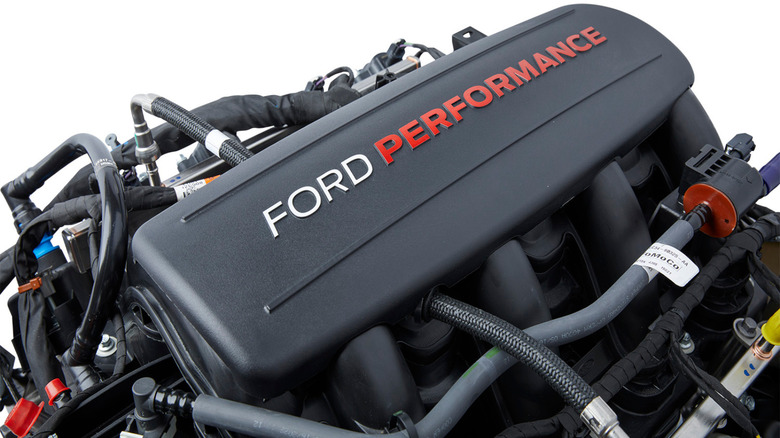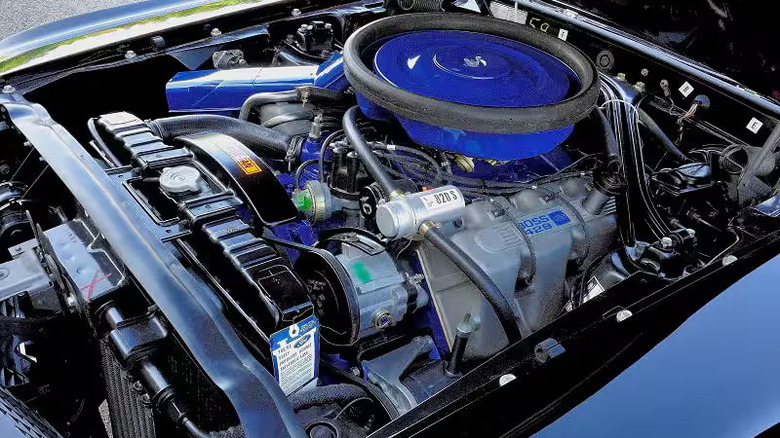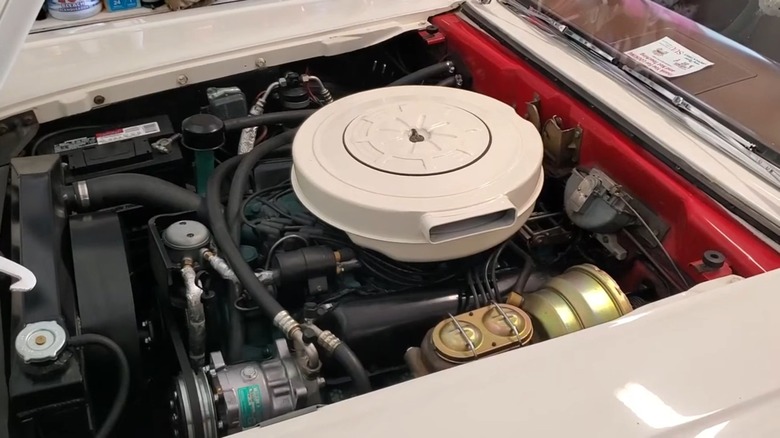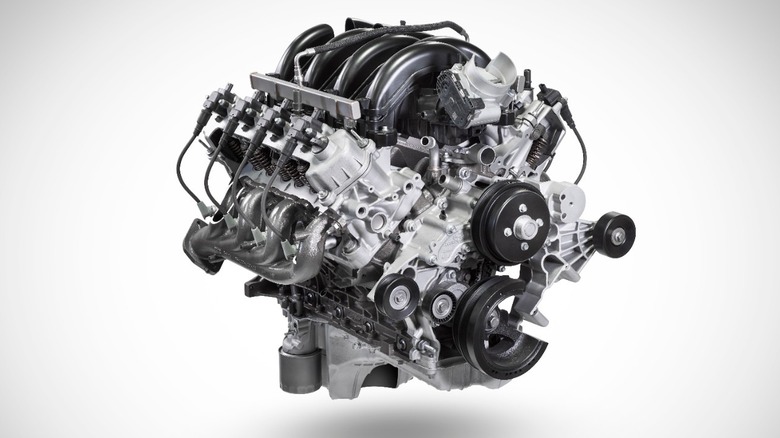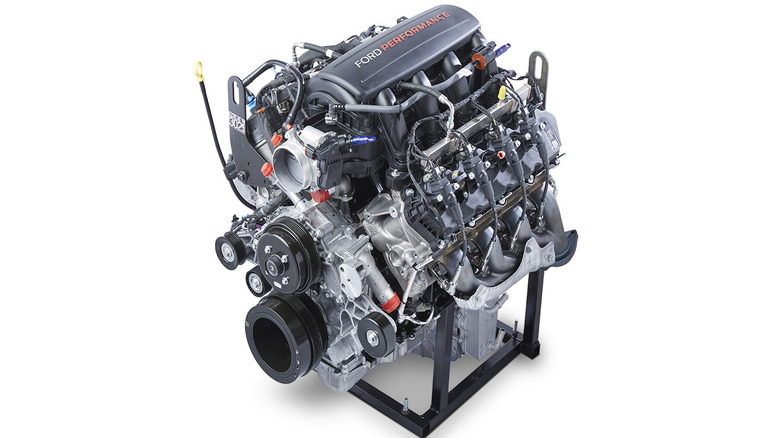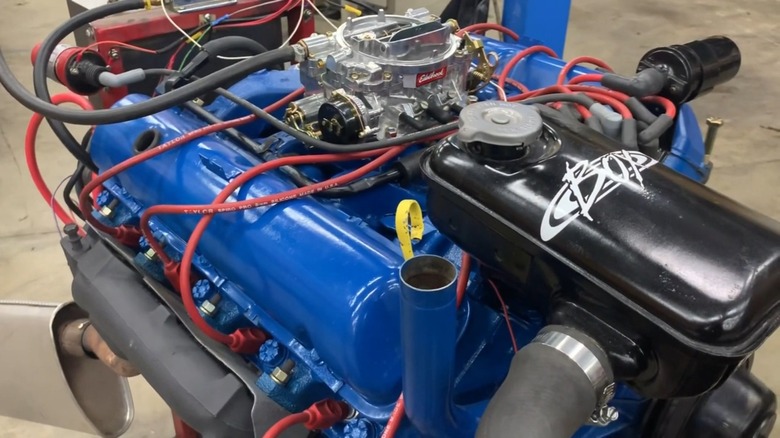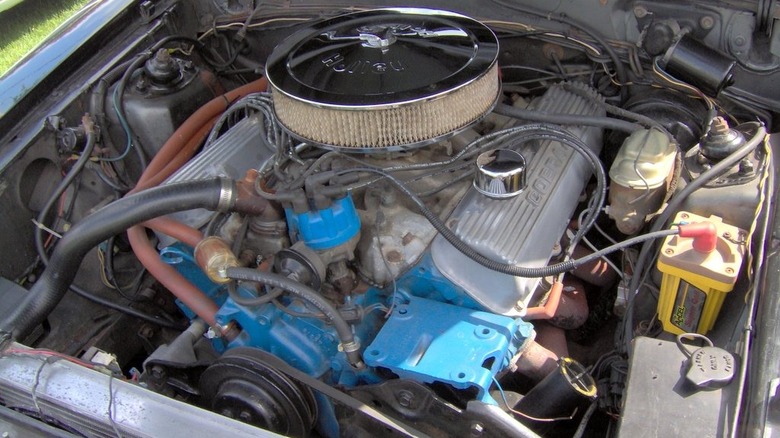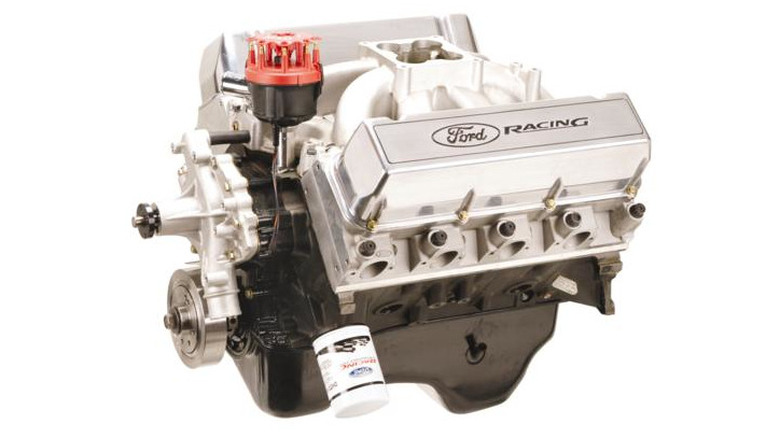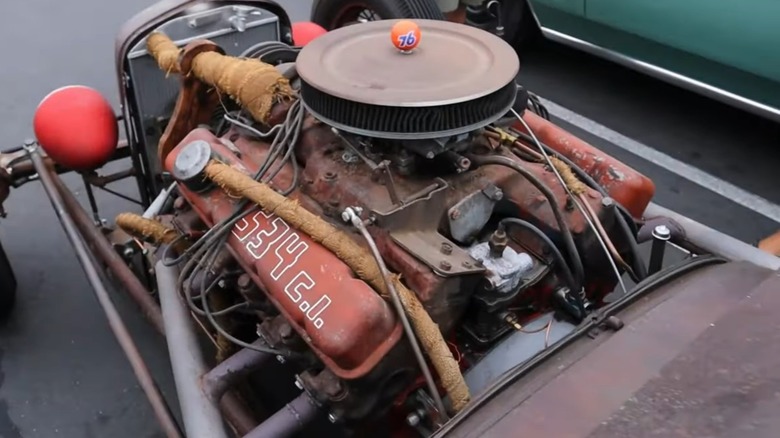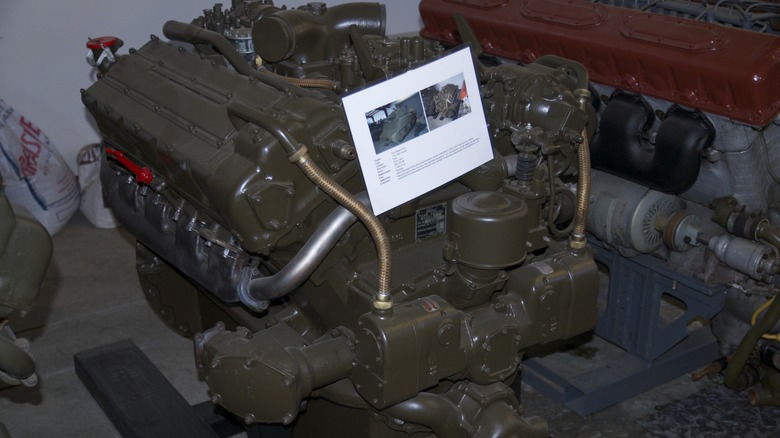10 Of The Biggest V8 Engines Ever Built By Ford, Ranked
Starting in 1932 with the Flathead V8 in the Model 18, Ford's V8s have powered a long line of iconic cars. Whether it's the '60s and '70s opulence of the Lincoln Continentals, the high-performance power of race-bred Boss 429 Mustang, or Ford's beefy 2020s Super Duty trucks, look under the hood and you'll almost inevitably find a V8 of some persuasion. While Ford has recently focused on four and six-cylinder engines — even in a supercar like the second-generation Ford GT — the company still flies the V8 flag in vehicles like the new 2024 Ford Mustang GT.
Unfortunately, the V8's time in the sun may be coming to an end. As the automotive industry moves toward greener, more efficient engines (not to mention EVs and hybrids), the V8, in all its raunchy, gas-guzzling glory, may eventually go the way of the dodo. Will the world be a duller place without them? Definitely, but let's not worry too much about what's to come just yet.
Instead, look back through the years at the largest V8s Ford has ever built and appreciate the beauty of a large-displacement V8. We'll start from Ford's relatively puny 7.0-liter 385 big block V8 of the late 1960s and go up to its enormous World War II-era 18-liter tank engine, with quite a few modern and vintage detours in between.
10. 7.0-liter 385 V8
Ford's 385 engine series was introduced in 1968 as a replacement for the MEL (Mercury-Edsel-Lincoln) V8s the company had been making up to that point. This seven-liter (429 CI) 385 was the second-largest 385 to debut that year and would eventually feature in a wide range of Ford cars, including the Thunderbird, Ranchero, and, of course, the Ford Mustang Boss 429, which takes its name from the engine's displacement in cubic inches.
The seven-liter 385 — named after the 3.85-inch stroke of the largest 7.5-liter version — had a 4.36-inch bore and 3.59-inch stroke and came as standard with a four-barrel carburetor. Ford rated the base version at 360 gross horsepower and 480 pound-feet of torque. However, the consensus is that Ford underrated the engine's output to keep insurance rates low for young, performance-conscious buyers.
Ford made several versions of the seven-liter 385 V8 engine, although the most iconic is likely the Boss 429 that powered the Mustang Boss 429. Ford developed the Boss 429 (and the Boss Mustang) for NASCAR, but had to release a road-going version to homologate it and make it legal for competition. Ford claimed that the Boss 429 produced 385 horsepower and 450 pound-feet of torque, although it has since admitted that these engines produced north of 500 horsepower. Ford also offered Cobra Jet and Super Cobra Jet versions of the 429 with extra power. These were options in cars like the 1970-71 Torino and Mustang, mated to close-ratio four-speed manual transmissions.
9. 7.0-liter MEL V8
Ford launched two big block V8s in 1958: the FE (Ford-Edsel) series, which topped out at 428 CI, and the MEL (Mercury-Edsel-Lincoln) engines, which trumped its stablemate ever so slightly by offering a 430 CI (seven-liter) version at launch. The seven-liter MEL V8 had a 4.30-inch bore and 3.70-inch stroke and was most commonly seen in Lincolns from 1958-1965, although it was also a short-lived option in select Mercury cars between 1958-1960 (including the Park Lane and Super Marauder) and the Ford Thunderbird (1959-1960).
Power and torque numbers for the seven-liter MEL V8 would change over the years. The most powerful incarnations came in its debut year, with cars like the 1958 Lincoln Continental Mark III boasting gross figures of 375 horsepower and 490 pound-feet of torque from the engine. However, there was an even more powerful version of the engine: Mercury's Super Marauder packed a modified MEL V8 with a triple-carburetor setup and new aluminum intake. These mods pushed the engine up to 400 horsepower and 480 pound-feet of torque, earning it a place in history as America's first-ever mass-produced 400-horsepower V8.
Sadly for horsepower lovers, things would only go downhill from there for the 7.0-liter MEL V8. By 1965, these numbers would drop to 320 horsepower and 465 pound-feet. Still impressive, but not quite the same. Ford would replace the 7.0-liter MEL V8 with a larger 7.5-liter engine the following year before phasing out the whole MEL engine family in favor of the 385 series of big block V8s.
8. 7.3-liter Godzilla V8
Ford's Godzilla V8 debuted in the 2020 Ford Super Duty as a brand-new engine option for that particular year (alongside an upgraded 6.7-liter diesel engine). The Godzilla V8 was a clean-sheet design Ford developed to be powerful, reliable, and affordable, all essential criteria for a pickup truck like the Super Duty.
What makes the Godzilla V8 interesting is its construction. Despite having the highly regarded Coyote V8 platform available, Ford opted for an old-school design with a pushrod valvetrain and wedge-shaped combustion chambers, a setup last seen on the 2001 Ford Explorer. But don't mistake the Godzilla V8 for an outdated anachronism in a world of fancy, high-tech engines: the 4.22-inch bore, 3.97-inch stroke Godzilla V8 is a thoroughly modern beast, with unique features such as a chain-driven oil pump alongside expected design choices like hydraulic roller lifters, variable valve timing, and high-flow aluminum cylinder heads.
The result? An engine with 430 horsepower and 475 pound-feet of torque — enough to make it one of Ford's most powerful engines — in a reasonably lightweight 540-pound package. This much power in such a relatively compact (and light) size makes the Godzilla V8 an appealing option for hot rods and drag cars, especially when tuners have shown that simple mods can bring the Godzilla V8 up to 600 horsepower. Thankfully, Ford knows this and sells the Godzilla V8 as a crate motor for $8,500 — no need to buy a donor Super Duty truck just to get your hands on an engine.
7. 7.3-liter Megazilla V8
The Godzilla V8 may be one of Ford's largest-ever V8 engines, but it's not necessarily all that powerful: With "only" 430 horsepower, it pales in comparison to rival General Motors' biggest V8s, some of which output 600 horsepower or more. Sure, a few choice mods can bring that number up without too many issues, but what if you want a drop-in Ford V8 with enough power to rival GM's modern LS engines? That's where the Megazilla V8 comes into the picture.
The Megazilla V8 is a souped-up Godzilla V8. It retains the pushrod construction and cast iron block but with a range of Ford Performance upgrades to increase the power and torque numbers to race-ready levels. On the inside, the Megazilla V8 sports parts such as CNC-ported aluminum cylinder heads, Mahle forged pistons, Callies H-beam forged connecting rods, and a high-performance camshaft. The intake system is new, too, with a low-profile intake manifold and the 92 mm throttle body from the 2020 Ford Mustang Shelby GT500 in place of the standard Godzilla V8 parts.
The result? 612 horsepower and 670 pound-feet of torque, with 500 pound-feet of that torque readily available between 2,500 to 6,000 RPM. And all without increased displacement or forced induction, either. You're probably guessing that this much goodness doesn't come cheap. You'd be right: Megazilla V8s cost $23,000 each, not including the extra components you still have to buy. That's about as much as you'd pay for a 2024 Ford Maverick — and that doesn't even come with the car.
6. 7.5-liter MEL V8
For most of its lifespan, Ford's MEL V8 engine family was ruled by a 7.0-liter unit that's likely best remembered for powering a range of Ford Motor Company vehicles in the late '50s and early-to-mid '60s and for being the first mass-produced American V8 to break the 400-horsepower barrier. In 1966, however, Ford decided it needed to update the MEL range and introduced a 7.5-liter unit to replace the 7.0-liter engine.
This new 7.5-liter MEL V8's increased displacement came from a larger 4.38-inch bore and 3.83-inch stroke. Combined with hydraulic lifters and a four-barrel Carter AFB carburetor, the 7.5-liter MEL V8 output a gross 340 horsepower and 485 pound-feet of torque when it debuted in the 1966 Lincoln Continental. This wasn't a massive increase over the previous year's Continental,but an extra 20 horsepower and 20 pound-feet of torque wasn't anything to scoff at. Every little bit of extra power helped, especially considering the 1966 Continental weighed more than 5,000 pounds in all three configurations (coupe, sedan, and four-door convertible).
Ford only built the 7.5-liter MEL V8 for a couple of years. By mid-1968, the company stopped building MEL V8s in favor of its new 385 family of big-block V8s, the 7.5-liter version of which would make its way into the 1969 Lincoln Continental.
5. 7.5-liter 385 V8
The 7.5-liter incarnation of Ford's legendary 385 V8 saw immediate action in 1969, debuting in the Lincoln Continental Mark III to replace the similarly sized 7.5-liter MEL V8. The 385 had a 3.85-inch stroke — thus the name — and delivered a healthy 365 gross horsepower and 485 pound-feet of torque when it debuted, a marginal upgrade over its predecessor's 340 horsepower.
Ford initially kept the 7.5-liter 385 V8 exclusive to the Lincoln Continental Mark III but changed tack in the early '70s. By 1973, prospective buyers could get the 7.5-liter 385 V8 in Mercurys, such as the Meteor and Marquis, and the 1973 Ford Thunderbird. Unfortunately, the engine that Ford made available in these cars wasn't quite the same as the one that debuted in 1969, with modifications to the motor and choke eventually leading to the 7.5-liter 385 only making a rated 200 horsepower and around 350 pound-feet of torque for most of the '70s.
Ford stopped offering the 7.5-liter 385 as an option in passenger vehicles in 1978 but continued to make it available in trucks and vans for many decades. The engine received an upgrade to fuel injection in 1988 — improving its output to 245 horsepower and 400 pound-feet of torque — and remained in use through most of the '90s in vehicles such as the Ford Econoline. Ford stopped offering the engine as an option in 1997, with the 1998 Econoline moving to V8 and V10 Triton engines.
4. 8.4-liter 385 V8
Despite pulling the 385 engines from passenger vehicles in the late 1990s, Ford never truly abandoned the 385 — case in point: the 2000s-era 8.4-liter 385 from Ford Racing. Ford Racing built this 8.4-liter V8 on a modified 460 short block with parts such as Eagle H-beam connecting rods, custom-forged 4.36-inch bore pistons, and a modular cast-iron 4.30-inch stroker crankshaft. The larger bore and stroke increased the engine's displacement despite using essentially the same block as the old 7.5-liter 385.
Ford combined this short block with Super Cobra Jet aluminum cylinder heads (with better airflow than standard 460 heads and design contributions from engine builder Jon Kaase), a Super Cobra Jet valve train, and a Victor Jr. single-plane intake manifold designed expressly to work with Holley Dominator carburetors. Ford also specced a solid roller mechanical camshaft, which it claimed helped improve horsepower output above 3,500 RPM without sacrificing torque output in the lower rev range.
The engine shipped mostly complete, with oil and water pumps, a multi-index timing chain, spark plugs, a flywheel, an oil pan, and valve covers included. This resulted in a cool 625 horsepower and 600 pound-feet of torque. Not bad for less than $8,000 — in mid-200s money, at least. Ford offered this 8.4-liter 385 until 2009 at least. It's unclear when the company discontinued the engine, but it disappeared from the catalog by the time Ford launched the 9.4-liter 385. More on that later.
3. 8.7-liter Super Duty V8
Ford's 7.3-liter Godzilla V8 is an undeniably bulky truck engine. Still, it pales in comparison to the 8.7-liter behemoth the company put in a range of its heavy-duty trucks throughout the 1960s and 1970s, including the larger F and C-series Super Duty trucks (850, 950, 1000, and 1100). First built in 1958, the Ford Super Duty V8s came in three displacements, of which the 8.7-liter was the largest.
The 8.7-liter Super Duty V8 had a 4.50-inch bore and 4.20-inch stroke and ran at a low (by modern standards) compression ratio of 7.5:1. Ford claimed gross power numbers of 270 horsepower and 481 pound-feet of torque, the latter starting at 1900 RPM. Ford didn't design the Super Duty V8 for outright performance. Instead, Ford designed these engines for reliability, with features like cooled spark plugs, dual thermostats, a three-stage cooling system, a built-in oil cooler, and sodium-cooled exhaust valves helping to keep the engine running at its best.
Despite that, the 8.7-liter Super Duty V8 did have a surprising second life as a performance engine — albeit not on the road. New York-based Seamaster Marine Co. produced two Super Seamaster marine engines based on the Super Duty V8. The base model was essentially a stock 8.7-liter Super Duty V8, with the same 277 horsepower number Ford quoted as stock. However, it also offered a much beefier "Ti" model with twin turbos and a more credible 400 horsepower.
2. 9.4-liter 385 V8
Ford's '00s 8.4-liter 385 wasn't the only time the company brought the 385 big block back in crate form. Following in the footsteps of custom engine builders and their high-power, high-displacement 385 V8s, Ford debuted the largest Ford-built incarnation of the 385 to date in 2018: A hulking 9.4-liter big block with a 4.50-inch bore and 4.50-inch stroke producing 655 horsepower and an impressive 710 pound-feet of torque.
Like its other high-performance crate engines (including the Megazilla V8), this 9.4-liter 385 sports many high-quality parts from Ford Performance and other big-name brands. The impressive parts list features a forged steel crankshaft and forged steel H-beam connecting rods (both from Scat Performance), ARP bolts, Diamond Racing pistons, and a hydraulic roller camshaft. The cylinder heads are Ford's Super Cobra Jet aluminum heads with dual valve springs, while the intake manifold is an Edelbrock Victor 2966 with a Holley Street Avenger carburetor topping it off.
Other trick engine components include a Jon Kaase oil pump, MSD distributor, Crower stainless steel rollers, and a bevy of in-house Ford Performance products for the timing chain, oil pan, spark plug wires, and vibration dampers. The engine comes almost entirely ready to go, with only a flywheel, water pump, and pulleys required to get it up and running in a vehicle. Unsurprisingly, this engine doesn't come cheap: expect to pay $19,750 for the privilege of cramming one into your hot rod's engine bay.
1. 18.0-liter Ford GAA V8
The 18-liter Ford GAA V8 engine stands head and shoulders above the company's other V8s, at least in sheer size. This massive hunk of metal has almost double the displacement of the second-largest V8 Ford ever built, but it could have been even bigger. Initially conceived in the 1940s as a 27-liter V12 plane engine to compete with the Rolls-Royce Merlin, Ford eventually cut the engine down to eight cylinders and a mere 18.0 liters when it pivoted to building engines for the M4 Sherman tank instead.
The GAA V8 was an all-aluminum engine with a 5.40-inch bore and 6.00-inch stroke. It boasted several advanced features for its day, including a true double overhead cam setup, a dual ignition system with two magnetos and twin spark plugs, plus two Stromberg NA-Y5-G carburetors in a crossflow induction setup. Ford was also ahead of the curve in terms of the accessory drive system, opting for a gear- and shaft-driven system without belts or chains. The upshot of opting for this more complicated design was reliability: Army tests of the time indicated that the GAA V8 compared favorably to the older diesel engines used in the Sherman.
The GAA V8 had a gross power output of 525 horsepower and 1,050 pound-feet of torque. The latter was crucial, giving it the grunt to move the Sherman's 68,000-pound bulk on the battlefield. After the war, GAA V8s were used in drag racing and tractor pulling, with some examples allegedly capable of producing 5,000 horsepower once modified.
